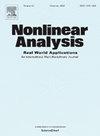Singular non-autonomous (p,q)-equations with competing nonlinearities
IF 1.8
3区 数学
Q1 MATHEMATICS, APPLIED
引用次数: 0
Abstract
We consider a parametric non-autonomous -equation with a singular term and competing nonlinearities, a parametric concave term and a Carathéodory perturbation. We consider the cases where the perturbation is -linear and where it is -superlinear (but without the use of the Ambrosetti–Rabinowitz condition). We prove an existence and multiplicity result which is global in the parameter (a bifurcation type result). Also, we show the existence of a smallest positive solution and show that it is strictly increasing as a function of the parameter. Finally, we examine the set of positive solutions as a function of the parameter (solution multifunction). First, we show that the solution set is compact in and then we show that the solution multifunction is Vietoris continuous and also Hausdorff continuous as a multifunction of the parameter.
具有竞争非线性的奇异非自治 (p,q) -方程
我们考虑的是一个参数非自治 (p,q) -方程,它包含一个奇异项和相互竞争的非线性、一个参数凹项和一个卡拉瑟奥多里扰动。我们考虑了扰动为 (p-1)- 线性和 (p-1)- 超线性(但不使用 Ambrosetti-Rabinowitz 条件)的情况。我们证明了参数 λ>0 全局性的存在性和多重性结果(分岔类型结果)。此外,我们还证明了一个最小正解的存在,并证明它作为参数的函数是严格递增的。最后,我们研究了作为参数函数的正解集(解的多重函数)。首先,我们证明解集在 C01(Ω̄) 中是紧凑的,然后我们证明解的多重函数是 Vietoris 连续的,并且作为参数的多重函数也是 Hausdorff 连续的。
本文章由计算机程序翻译,如有差异,请以英文原文为准。
求助全文
约1分钟内获得全文
求助全文
来源期刊
CiteScore
3.80
自引率
5.00%
发文量
176
审稿时长
59 days
期刊介绍:
Nonlinear Analysis: Real World Applications welcomes all research articles of the highest quality with special emphasis on applying techniques of nonlinear analysis to model and to treat nonlinear phenomena with which nature confronts us. Coverage of applications includes any branch of science and technology such as solid and fluid mechanics, material science, mathematical biology and chemistry, control theory, and inverse problems.
The aim of Nonlinear Analysis: Real World Applications is to publish articles which are predominantly devoted to employing methods and techniques from analysis, including partial differential equations, functional analysis, dynamical systems and evolution equations, calculus of variations, and bifurcations theory.

 求助内容:
求助内容: 应助结果提醒方式:
应助结果提醒方式:


